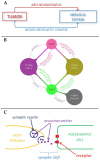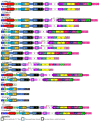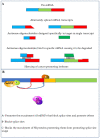Many Voices in a Choir: Tumor-Induced Neurogenesis and Neuronal Driven Alternative Splicing Sound Like Suspects in Tumor Growth and Dissemination
- PMID: 33946706
- PMCID: PMC8125307
- DOI: 10.3390/cancers13092138
Many Voices in a Choir: Tumor-Induced Neurogenesis and Neuronal Driven Alternative Splicing Sound Like Suspects in Tumor Growth and Dissemination
Abstract
During development, as tissues expand and grow, they require circulatory, lymphatic, and nervous system expansion for proper function and support. Similarly, as tumors arise and develop, they also require the expansion of these systems to support them. While the contribution of blood and lymphatic systems to the development and progression of cancer is well known and is targeted with anticancer drugs, the contribution of the nervous system is less well studied and understood. Recent studies have shown that the interaction between neurons and a tumor are bilateral and promote metastasis on one hand, and the formation of new nerve structures (neoneurogenesis) on the other. Substances such as neurotransmitters and neurotrophins being the main actors in such interplay, it seems reasonable to expect that alternative splicing and the different populations of protein isoforms can affect tumor-derived neurogenesis. Here, we report the different, documented ways in which neurons contribute to the development and progression of cancer and investigate what is currently known regarding cancer-neuronal interaction in several specific cancer types. Furthermore, we discuss the incidence of alternative splicing that have been identified as playing a role in tumor-induced neoneurogenesis, cancer development and progression. Several examples of changes in alternative splicing that give rise to different isoforms in nerve tissue that support cancer progression, growth and development have also been investigated. Finally, we discuss the potential of our knowledge in alternative splicing to improve tumor diagnosis and treatment.
Keywords: alternative splicing; cancer growth and development; neoneurogenesis; nerves; therapeutic targets.
Conflict of interest statement
The authors declare no conflict of interest.
Figures










Similar articles
-
Regulation of Neuronal Differentiation, Function, and Plasticity by Alternative Splicing.Annu Rev Cell Dev Biol. 2018 Oct 6;34:451-469. doi: 10.1146/annurev-cellbio-100617-062826. Epub 2018 Jul 20. Annu Rev Cell Dev Biol. 2018. PMID: 30028642 Free PMC article. Review.
-
Genomic Interplay between Neoneurogenesis and Neoangiogenesis in Carcinogenesis: Therapeutic Interventions.Cancers (Basel). 2023 Mar 16;15(6):1805. doi: 10.3390/cancers15061805. Cancers (Basel). 2023. PMID: 36980690 Free PMC article. Review.
-
Tumour-induced neoneurogenesis and perineural tumour growth: a mathematical approach.Sci Rep. 2016 Feb 10;6:20684. doi: 10.1038/srep20684. Sci Rep. 2016. PMID: 26861829 Free PMC article.
-
Alternative splicing in Drosophila neuronal development.J Neurogenet. 2014 Sep-Dec;28(3-4):199-215. doi: 10.3109/01677063.2014.936437. Epub 2014 Jul 21. J Neurogenet. 2014. PMID: 24957133 Review.
-
Tumor progression: the neuronal input.Ann Transl Med. 2018 Mar;6(5):89. doi: 10.21037/atm.2018.01.01. Ann Transl Med. 2018. PMID: 29666812 Free PMC article. Review.
Cited by
-
Interleukin-17 signaling influences CD8+ T cell immunity and tumor progression according to the IL-17 receptor subunit expression pattern in cancer cells.Oncoimmunology. 2023 Oct 5;12(1):2261326. doi: 10.1080/2162402X.2023.2261326. eCollection 2023. Oncoimmunology. 2023. PMID: 37808403 Free PMC article.
-
Neural stem cell research in Africa: current realities and future prospects.Biol Open. 2022 Nov 1;11(11):bio059574. doi: 10.1242/bio.059574. Epub 2022 Nov 3. Biol Open. 2022. PMID: 36326097 Free PMC article. Review.
-
Tumor Innervation: History, Methodologies, and Significance.Cancers (Basel). 2022 Apr 14;14(8):1979. doi: 10.3390/cancers14081979. Cancers (Basel). 2022. PMID: 35454883 Free PMC article. Review.
-
Peak density of immature nerve cells occurs with high-grade dysplasia in intraductal papillary mucinous neoplasms of the pancreas.J Pathol. 2022 Sep;258(1):69-82. doi: 10.1002/path.5978. Epub 2022 Jul 18. J Pathol. 2022. PMID: 35686747 Free PMC article.
-
Microbiomics in Collusion with the Nervous System in Carcinogenesis: Diagnosis, Pathogenesis and Treatment.Microorganisms. 2021 Oct 11;9(10):2129. doi: 10.3390/microorganisms9102129. Microorganisms. 2021. PMID: 34683450 Free PMC article. Review.
References
-
- Langley J.N. The autonomic nervous system. Brain. 1903;26:1–26. doi: 10.1093/brain/26.1.1. - DOI
Publication types
Grants and funding
LinkOut - more resources
Full Text Sources
Other Literature Sources

